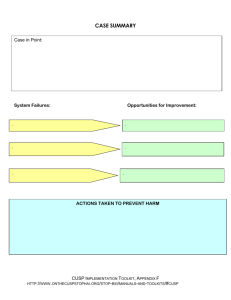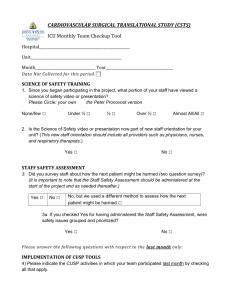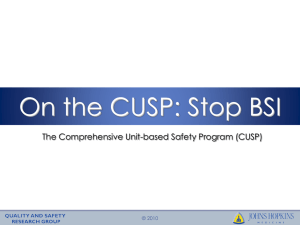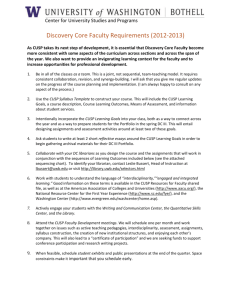Cusp equivalence between smooth embeddings of the 2{sphere in 4{space Takao Matumoto
advertisement
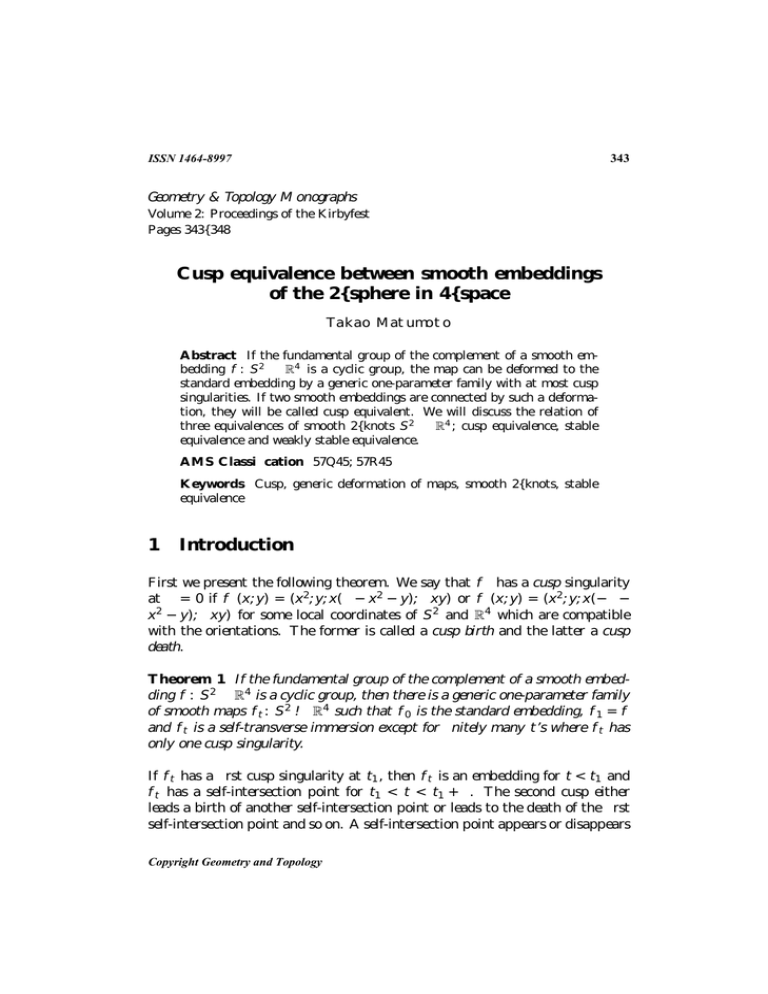
343
ISSN 1464-8997
Geometry & Topology Monographs
Volume 2: Proceedings of the Kirbyfest
Pages 343{348
Cusp equivalence between smooth embeddings
of the 2{sphere in 4{space
Takao Matumoto
Abstract If the fundamental group of the complement of a smooth embedding f : S 2 R4 is a cyclic group, the map can be deformed to the
standard embedding by a generic one-parameter family with at most cusp
singularities. If two smooth embeddings are connected by such a deformation, they will be called cusp equivalent. We will discuss the relation of
three equivalences of smooth 2{knots S 2 R4 ; cusp equivalence, stable
equivalence and weakly stable equivalence.
AMS Classication 57Q45; 57R45
Keywords Cusp, generic deformation of maps, smooth 2{knots, stable
equivalence
1
Introduction
First we present the following theorem. We say that f has a cusp singularity
at = 0 if f (x; y) = (x2 ; y; x( − x2 − y); xy) or f (x; y) = (x2 ; y; x(− −
x2 − y); xy) for some local coordinates of S 2 and R4 which are compatible
with the orientations. The former is called a cusp birth and the latter a cusp
death.
Theorem 1 If the fundamental group of the complement of a smooth embedding f : S 2 R4 is a cyclic group, then there is a generic one-parameter family
of smooth maps ft : S 2 ! R4 such that f0 is the standard embedding, f1 = f
and ft is a self-transverse immersion except for nitely many t’s where ft has
only one cusp singularity.
If ft has a rst cusp singularity at t1 , then ft is an embedding for t < t1 and
ft has a self-intersection point for t1 < t < t1 + . The second cusp either
leads a birth of another self-intersection point or leads to the death of the rst
self-intersection point and so on. A self-intersection point appears or disappears
Copyright Geometry and Topology
344
Takao Matumoto
at a cusp birth or a cusp death respectively. Theorem 1 is easily extended to a
connected embedded surface in R4 . In the case of non-orientable surfaces there
are several unknotted embeddings which are not isotopic because they have
dierent normal Euler numbers but they are connected by such a deformation.
Kamada also gave a proof of the generalized version of Theorem 1 in [2].
Let f0 (S 2 ) and f1 (S 2 ) be the image of two embedded 2{spheres. These 2{knots
can be equivalent in the following three senses.
(1) They are cusp equivalent if they are connected by a generic one-parameter
family fft g of smooth maps such that ft is a self-transverse immersion except
for nitely many values of t at which ft has only one cusp singularity.
(2) They are stably equivalent if they are ambient isotopic after trivial 1{
handles are attached. That is, they are ambient isotopic after a genus g unknotted orientable surface is attached as a connected summand to each.
(3) They are weakly stably equivalent if, for some n 0, they are ambient
isotopic in R4 #(#n S 2 S 2 ).
If ft is a generic deformation with at most cusp singularities, then the fundamental group of the complement is kept constant during the deformation. We
have the following theorem.
Theorem 2 Assume that two smooth 2{knots f0 : S 2 R4 and f1 : S 2 R4
are cusp equivalent. Then they are stably equivalent.
Theorem 2 is easily generalized to the case of embedded orientable surfaces of
positive genus. In the case of embedded non-orientable surfaces we need the
additional condition that they have the same normal Euler numbers.
Theorem 3 Stably equivalent 2{knots S02 R4 and S12 R4 are weakly
stably equivalent.
Theorem 1 should be known to specialists who are familiar both with 2{knot
theory and singularity theory. But since it would give a starting point for a
possible proof of the smooth 4{dimensional unknotting conjecture, I would like
to dedicate this short paper to Professor R Kirby. I would also like to thank
the referee who read the manuscript carefully and oered a beautiful gure to
simplify the proof of Theorem 2.
Geometry and Topology Monographs, Volume 2 (1999)
Cusp equivalence
2
345
Proof of the Theorems
Proof of Theorem 1 Since any two maps of S 2 into R4 are mutually homotopic, there is a generic one-parameter family of smooth maps ft : S 2 ! R4
connecting f0 and f1 . By dimensional reasoning, the generic births and deaths
of self-intersection points have only two types; nger moves and cusps. In fact
at a nite number of t’s the image of ft has a cusp or a partial tangency of two
local sheets. By a nger move we mean the local deformation including the latter non-transverse case; a nger pushes a local sheet until it penetrates another
local sheet. We get a pair of self-intersection points after the penetration with
one plus and one minus intersection number. Note that the reverse process of
the nger move is a Whitney trick. We may think that the nger move follows
along a curve that connects two points of S 2 . If the fundamental group of the
complement is a cyclic group generated by the element encircling the surface,
the curve is homotopically trivial relative boundary and hence isotopically
trivial; so, we get a 2{disk D with two corners and @D = [ (D \ S 2 ). Now
it is not dicult to decompose this nger move into two cusp births.
The reverse deformation around the cusp birth, that is, the cusp death process
can be described by the collapsing of a 2{disk D with one corner such that
@D = D \ fimmersed S 2 g and the corner point on the boundary is the selfintersection point. Moreover we have two types of cusps for the cusp birth;
one gives a positive intersection point and another gives a negative one for
the appearing immersed surface. If the nger move is isotopically trivial, we
can construct a pair of disjoint collapsing 2{disks for the pair of positive and
negative self-intersection points and get a pair of positive and negative cusps.
This completes the proof of Theorem 1. For another proof one may consult the
manuscript written by Kamada [2].
Before giving a proof of Theorem 2 we recall the denition of trivial 1{handles.
An embedded product, B I , of a 2{disk B and an interval I in R4 is said
to span S 2 as a 1{handle if (B I) \ S 2 = B f0; 1g \ S 2 and the surface
obtained by the surgery according to B I has an orientation compatible with
the original one. The circle = @B 1=2 parallel to the boundary of @B I
is considered. The 1{handle is called trivial if there is a 2{disk D such that
D \ ((B I) [ S 2 ) = @D and @D \ = a point.
By a smoothing of a transverse double point we mean replacing a neighborhood
of the transverse double point with a standard annulus connecting the components of a Hopf link in the boundary 3{sphere. When the surface is oriented,
Geometry and Topology Monographs, Volume 2 (1999)
346
Takao Matumoto
the smoothing should respect the orientation and the isotopy class of the resulting surface is uniquely determined. Since a cusp birth is described also by
f (x; y) = (x2 ; y; x( − x2 − y 2 ); xy), an oriented smoothing of the double
point appearing at the cusp birth is shown in Figure 1.
Figure 1: Smoothing a double point
We can nd easily B I and D of a trivial 1{handle in the gure. If the sign
of the cusp birth is reversed, the upper and lower curves at the crossing in the
gure are reversed. So, we obtain:
Lemma Let F0 be an oriented immersed surface in R4 , and let F1 be a
surface obtained from F0 by a single cusp birth. Let F2 be obtained from F1
by smoothing the double point that appears following the cusp birth. Then F2
is obtained from F0 by surgery along a trivial 1{handle.
Proof of Theorem 2 Let f1 (S 2 ) = S12 and f2 (S 2 ) = S22 be embedded 2{
spheres in R4 that are cusp equivalent. The one-parameter family fft g can be
deformed so that any cusp birth takes place at t < 1=2 and any cusp death
takes place at t > 1=2. So we may assume that there is an immersed 2{sphere
f1=2 (S 2 ) = S in R4 such that S can be obtained from either S12 or S22 by
attaching m cusps for some m. Let F be the embedded surface obtained from
S by smoothing all the double points of S . The result follows from the previous
lemma.
I thank the referee for oering the use of Figure 1 which simplies the proof of
Theorem 2 greatly.
Geometry and Topology Monographs, Volume 2 (1999)
Cusp equivalence
347
Proof of Theorem 3 The surface which is obtained by attaching n trivial
1{handles is a connected sum of the original 2{knot and an unknotted surface
F of genus n in the sense of [1]. Since the bounding solid tori for the unknotted
surfaces F are ambient isotopic to each other by Corollary 1.6 of [1], we may
assume that there is an orientation preserving dieomorphism h of R4 to itself
which not only satises h(S02 #F ) = S12 #F but also preserves the circles ’s
determined by the trivial 1{handles. Now we consider each trivial 1{handle.
Perform surgery along the loop on the embedded surface which intersects the
circle at one point for the trivial 1{handle recursively. We have to respect
the stable framing when making the surgery. Then we get a 2{knot in the new
ambient manifold, the connected sum of R4 with n copies of S 2 S 2 . Let
Ds be the core 2{disk of the surgery disk and Do the original Whitney type
2{disk for the trivial 1{handle. The 2{disks Do ’s depend on each of the original
2{knots. If we do surgery on the new ambient manifold along each 2{sphere
Ds [ Do , we get the original 2{knot in R4 . So, doing the reversing surgery n
times for the complement of each of S02 and S12 again, we get Theorem 3.
3
On the generalization
The generalization of Theorem 1 to an embedded connected surface in R4 is
straightforward.
In the case of RP 2 we have a generic one-parameter family with only a pair of
cusp births and deaths connecting the unknotted surfaces with normal Euler
numbers 2 and −2. Here the normal Euler number means half of the intersection number of the zero section of the induced disk bundle for the normal bundle
of the immersed unoriented surface with respect to its orientable 2{covering.
The proof of Theorem 2 is easily generalized to an oriented surface of positive
genus because the sign of a cusp birth or death is determined by the intersection
number of the self-intersection point of the central oriented immersed surface.
Also, if the intersection number of the self-intersection point is positive or negative, its contribution to the normal Euler number of the immersed surface is
−2 or +2 respectively [3] and the procedure of Lemma annuls this contribution
in the case of oriented smoothing.
But in the case of non-orientable surfaces we cannot distinguish a positive or
negative cusp after it turns into a self-intersection point. So, a double point
which appears at a positive cusp birth may terminate at a negative cusp death.
In this case the smoothing double point cannot respect the local orientation
Geometry and Topology Monographs, Volume 2 (1999)
348
Takao Matumoto
near the cusp and if the cusp birth is smoothed by attaching a trivial 1{handle
then the cusp death is smoothed by attaching two unknotted RP 2 ’s with the
same Euler number. Nevertheless, if the normal Euler numbers of two embeddings f0 and f1 are the same, the number of positive cusp births and positive
cusp deaths should be equal and similarly the number of negative ones. Hence,
if a self-intersection point born at a positive cusp dies at a negative cusp, there
is also a self-intersection point born at a negative cusp and dieing at a positive
cusp and vice versa. So, if the cusp births are smoothed by attaching 1{handles,
then the cusp deaths are smoothed by attaching the connected sum of unknotted tori and RP 2 ’s with zero total Euler number. Since the connected sums of
the unknotted RP 2 with the unknotted torus and with two unknotted RP 2 ’s
with Euler number −2 and 2 are isotopic, cusp equivalent non-orientable surfaces with the same Euler number are stably equivalent after possibly taking
connected sum of each with an unknotted RP 2 .
If the notion of stable equivalence for non-orientable surfaces is enlarged to
include the connected sum with unknotted RP 2 ’s, then we can drop the hypothesis that the normal Euler numbers are the same.
As for Theorem 3, if the 1{handles are preserved by an ambient isotopy for
stably equivalent embedded surfaces, they are easily shown to be weakly stably
equivalent. We expect this to be true in general but we might have some
diculties even in the orientable case.
References
[1] F Hosokawa, A Kawauchi, Proposals for unknotted surfaces in four{spaces,
Osaka J. Math. 16 (1979) 233{248
[2] S Kamada, On a generic one-parameter family of maps of a surface into 4{
space, Preprint (1998)
[3] W S Massey, Proof of a conjecture of Whitney, Pacic J. Math. 31 (1969)
143{156
[4] T Matumoto, On a weakly unknotted 2{sphere in a simply-connected 4{
manifold, Osaka J. Math. 21 (1984) 489{492
[5] V A Rokholin, Two{dimensional submanifolds of four{dimensional manifolds,
Funktsional. Anal. i Prilozhen. 5 (1971) 48{60
Department of Mathematics, Faculty of Science, Hiroshima University
Higashi-Hiroshima 739-8526, Japan
Email: matumoto@math.sci.hiroshima-u.ac.jp
Received: 30 December 1998
Revised: 12 April 1999
Geometry and Topology Monographs, Volume 2 (1999)
